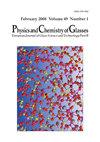Structural investigation of hydrous phosphate glasses
IF 0.3
4区 材料科学
Q4 CHEMISTRY, PHYSICAL
Physics and Chemistry of Glasses-European Journal of Glass Science and Technology Part B
Pub Date : 2019-04-17
DOI:10.13036/17533562.60.2.041
引用次数: 6
Abstract
Dissolved water has major impact on the physical and chemical properties of phosphate glasses. In the present study we have investigated the structural response to water incorporation for glasses in the system Li2O–MgO–Al2O3–P2O5. Glasses containing 0–8 wt% H2O were synthesised at 500 MPa confining pressure in internally heated gas pressure vessels at 1323 K (LMP, Al-poor glass) and 1423 K (LMAP, Al-enriched glass). Water contents of glasses were determined by pyrolysis and subsequent Karl-Fischer titration (KFT) and/or by infrared spectroscopy. Density varies nonlinearly with water content implying large structural changes when adding up to 2 wt% H2O to the dry glass. Glass Transition temperatures measured by differential thermal analysis (DTA) continuously decrease with water content. The trend can be explained by depolymerisation of the phosphate network. Near-infrared spectroscopy shows that even in Al poor glasses only a minority of dissolved water is present as H2O molecules, but the largest amount is present as OH Groups formed by hydrolysis of P–O–P bonds. The network is stabilised by aluminium which is predominantly six-coordinated in these glasses as shown by 27Al MAS NMR spectroscopy. With increase of Al in the glasses, breaking up of the Phosphate network through hydrolysis is depressed, i.e. much lower OH Contents are formed at same total water content. Network depolymerisation upon addition of H2O is evident also from 31P MAS NMR spectroscopy. While Phosphate tetraheda are crosslinked by two to three bridging oxygen in dry glasses, diphosphate Groups are dominant in glasses containing 8 wt% H2O.含水磷酸盐玻璃的结构研究
溶解的水对磷酸盐玻璃的理化性能有很大的影响。在本研究中,我们研究了Li2O-MgO-Al2O3-P2O5体系中玻璃对水掺入的结构响应。在1323 K (LMP,贫铝玻璃)和1423 K (LMAP,富铝玻璃)的内加热气体压力容器中,在500 MPa围压下合成了含0-8 wt% H2O的玻璃。通过热解和随后的卡尔-菲舍尔滴定法(KFT)和/或红外光谱法测定玻璃的含水量。密度随含水量非线性变化,这意味着当向干玻璃中加入2wt %的水时,会发生很大的结构变化。差热分析(DTA)测定的玻璃化温度随着水的含量不断降低。这种趋势可以用磷酸盐网络的解聚合来解释。近红外光谱分析表明,即使在贫铝玻璃中,也只有少数溶解的水以H2O分子的形式存在,而大部分以P-O-P键水解形成的OH基团的形式存在。该网络由铝稳定,铝在这些玻璃中主要是六配位的,如27Al MAS NMR所示。随着玻璃中Al含量的增加,磷酸盐网络的水解分解被抑制,即在相同的总含水量下形成更低的OH含量。加入水后的网络解聚也明显从31P MAS核磁共振光谱。磷酸四面体在干燥玻璃中由两到三个桥接氧交联,而二磷酸基团在含8wt % H2O的玻璃中占主导地位。
本文章由计算机程序翻译,如有差异,请以英文原文为准。
求助全文
约1分钟内获得全文
求助全文
来源期刊

CiteScore
0.70
自引率
33.30%
发文量
0
审稿时长
1 months
期刊介绍:
Physics and Chemistry of Glasses accepts papers of a more purely scientific interest concerned with glasses and their structure or properties. Thus the subject of a paper will normally determine the journal in which it will be published.
 求助内容:
求助内容: 应助结果提醒方式:
应助结果提醒方式:


